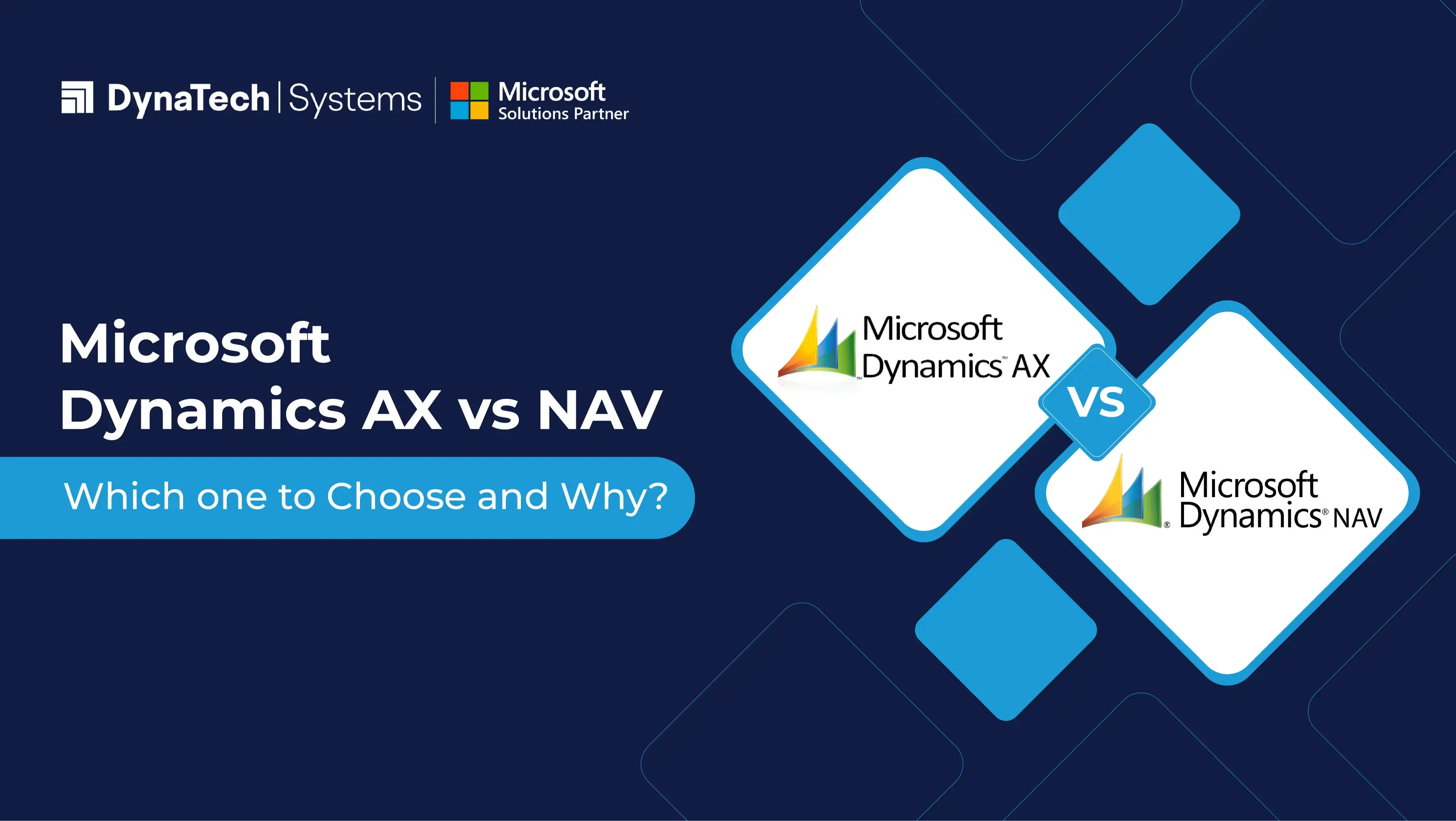Microsoft has long been a dominant force, offering a range of powerful tools like Enterprise Resource Management (ERP) to streamline business operations. Two of its flagship products, Microsoft Dynamics AX (formerly MS Axapta and now Dynamics 365 for Finance and Operations) and NAV (formerly Navision and now Dynamics 365 Business Central) stand out as top contenders in the ERP landscape.
Both solutions offer robust capabilities tailored to meet the unique requirements of businesses across various industries. However, when it comes to selecting the right ERP system for your organization, the choice between Dynamics AX and NAV can be daunting. In this comprehensive guide, we'll delve into the intricacies of each platform to help you choose the best solution for your enterprise.
Understanding Dynamics AX and Dynamics NAV
- Dynamics AX (Axapta): Traditionally positioned as an enterprise-grade ERP, Dynamics AX is designed for large, multinational corporations with complex business processes. It excels in handling high volumes of data, supporting multiple languages and currencies, and managing intricate supply chain operations across geographically dispersed locations.

- Dynamics NAV (Navision): Tailored for small and medium-sized businesses (SMBs), Navision ERP software, or Dynamics NAV offers a user-friendly interface and robust core functionalities. It caters well to companies with a single or limited number of locations and focuses on streamlining core business processes like finance, inventory, and sales.

Key Considerations for Choosing the Best Between Dynamics AX and NAV
Here's a breakdown of the critical factors to consider while choosing the right ERP system for your business:
1. Company Size and Complexity
- Dynamics AX: Ideally suited for large enterprises with multiple locations, subsidiaries, and complex operational structures. It can handle a high number of users, vast data sets, and intricate business rules.
- Dynamics NAV: A perfect fit for SMBs with simpler operational needs. It renders a scalable solution that can grow with your business.
2. Functionality and Features
- Dynamics AX: Offers a comprehensive suite of advanced features encompassing finance, supply chain management, manufacturing, project management, human capital management (HCM), and CRM. It caters to a wider range of industry-specific needs.
- Dynamics NAV: Provides core functionalities in finance, accounting, inventory control, sales, and purchasing. While it can be customized to meet specific needs, the range of pre-built features is narrower compared to AX.
3. Implementation and Cost
- Dynamics AX: The complexity of Dynamics AX translates to a higher cost of implementation and ongoing maintenance. Implementation times can be longer due to extensive customization requirements.
- Dynamics NAV: Generally quicker and less expensive to implement compared to AX. The user-friendly interface simplifies training and reduces ongoing support costs.
4. Scalability and Flexibility
- Dynamics AX: Highly scalable to accommodate significant growth and changing business needs. However, customization can be complex and resource intensive.
- Dynamics NAV: Offers good scalability for SMBs looking to expand. The modular design allows for easier customization to accommodate specific business processes.
5. Deployment Options
- Dynamics AX: Traditionally offered on-premise deployments, but Microsoft is transitioning towards cloud-based solutions (Dynamics 365 for Finance and Operations).
- Dynamics NAV: Available on-premise and in the cloud (Dynamics 365 Business Central). The cloud version offers easier deployment and lower upfront costs.
6. User Interface and Accessibility
- Dynamics AX: Dynamics AX features a modern and intuitive user interface designed to escalate productivity and streamline workflows for users across various roles and departments.
- Dynamics NAV: Dynamics NAV also offers a user-friendly interface, along with a more simplified design suited to the needs of smaller organizations.
7. Integration Capabilities
Dynamics AX and NAV both offer robust integration capabilities, allowing users to connect with Microsoft's suite of productivity tools such as Office 365, Power BI, and Azure services. Additionally, both platforms support integration with third-party applications through APIs and connectors.
Quick Comparison Chart
|
Key Considerations |
Dynamics AX |
Dynamics NAV |
|
Company Size |
Suited for large enterprises |
Ideal for SMBs |
|
Complexity |
Complex operational structures |
Scalable solution |
|
Functionality and Features |
Advanced features across various modules |
Core functionalities in finance, accounting, inventory control, sales, and purchasing |
|
Implementation and Cost |
Higher implementation and ongoing maintenance costs |
Less Expensive |
|
Time |
Longer Implementation Times |
Quicker Implementation Times |
|
Scalability and Flexibility |
Highly scalable |
Good scalability for SMBs |
|
Deployment Options |
Transitioning towards cloud-based solutions (Dynamics 365) |
On-premise and cloud options (Dynamics 365 Business Central) |
|
User Interface and Accessibility |
Modern and intuitive interface |
User-friendly interface |
|
Integration Capabilities |
Robust integration with MS suite (Office 365, Power BI, Azure) Third-party app integration |
Robust integration capabilities with MS suite and third-party applications via APIs/connectors
|
Factors That Influence the Decision
- Business Size and Complexity: The size and complexity of your enterprise's operations are important considerations while choosing between Dynamics AX and NAV. Large enterprises with critical business processes and global operations may benefit from the advanced capabilities and scalability of Dynamics AX. Conversely, SMEs with simpler requirements and limited resources may find Dynamics NAV to be a more cost-effective and practical solution.
- Industry-Specific Needs: Certain industries have unique requirements and regulations that must be addressed by ERP systems. Dynamics AX and Dynamics NAV software both offer industry-specific solutions and vertical extensions tailored to meet the needs of various sectors such as manufacturing, retail, distribution, and professional services. Evaluating the compatibility of each platform with your industry-specific requirements is essential in making the right choice.
- Budget and Total Cost of Ownership (TCO): Cost considerations are paramount when selecting an ERP system, including initial licensing fees, implementation costs, ongoing maintenance, and support expenses. While Dynamics AX may entail higher upfront investment and implementation costs due to its enterprise-grade features and scalability, Dynamics NAV typically offers a more budget-friendly option for SMEs with limited financial resources.
- Deployment Options: Both Dynamics AX and ERP system Dynamics NAV offer flexible deployment options, including on-premises, cloud, and hybrid deployments. Dynamics AX provides a cloud-first approach with Azure-hosted deployments, offering scalability, flexibility, and reduced IT infrastructure costs for large enterprises. Dynamics NAV also supports cloud deployment through Microsoft's Dynamics 365 Business Central, making it an attractive option for SMEs seeking a hassle-free, scalable solution with minimal IT overhead. On-premises deployment is still available for organizations with specific compliance or security requirements that necessitate hosting ERP systems in-house.
- Data Analytics and Reporting: Both Dynamics AX and NAV offer robust reporting tools and analytics features, enabling users to generate customizable reports, dashboards, and KPIs to monitor performance and identify trends. Dynamics AX leverages the power of Microsoft Power BI for advanced analytics and data visualization, making it a preferred choice for large enterprises with sophisticated reporting requirements. Dynamics NAV also provides built-in reporting tools and integration with Power BI, offering SMEs the ability to leverage data-driven insights to optimize operations and drive growth.
- Future Growth and Expansion Plans: Your organization's growth trajectory and expansion plans should also factor into your ERP selection process. If you want significant growth and expansion in the foreseeable future, opting for a scalable solution like Dynamics AX may provide the flexibility and scalability needed to support your evolving business needs. However, if your growth projections are more modest, Dynamics NAV may offer a more practical and cost-effective solution without overburdening your resources.
Choosing the Right Fit for Your Business
Here's a quick guide to help you decide:
Choose Dynamics 365 for Finance and Operations (formerly Dynamics AX) if:
- You are a large, multinational corporation with complex business processes.
- You require advanced functionalities like multi-language and multi-currency support.
- You have a high volume of data and a large number of users.
Choose Dynamics 365 Business Central (formerly Dynamics NAV) if:
- You are a small or medium-sized business.
- You need a user-friendly and cost-effective ERP solution.
- You prioritize core functionalities like finance, inventory, and sales management.
Final Thoughts
In conclusion, the choice between Microsoft Dynamics AX and NAV depends on various factors, including organization size, complexity, customization requirements, deployment preferences, support needs, analytics capabilities, migration considerations, and user adoption strategies. By carefully evaluating these factors and conducting a thorough analysis of each platform's strengths and weaknesses, organizations can make an informed decision that perfectly aligns with their business objectives, enhances operational efficiency, and drives sustainable growth.
Still confused about choosing the best one. Our consultants at DynaTech Systems can guide you in the entire journey. Get Started Now!




























